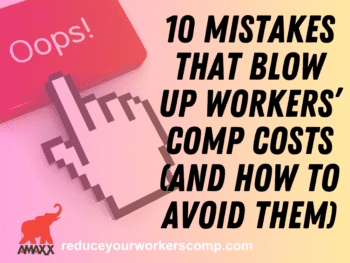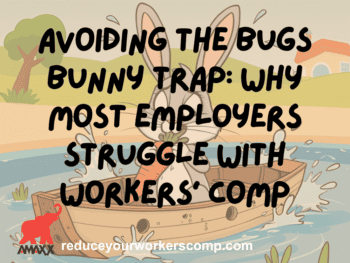
Below we discuss the top 5 misconceptions surrounding the mystery world of workers compensation. Not all of these will apply exactly to every jurisdiction but are general. Remember to discuss with the adjuster and counsel any exact questions surrounding certain details regarding.
Click Link to Access Free PDF Download
-
Workers Compensation is not Welfare
Compensation is not a free payment a worker is entitled. Just because you are injured at work, it does not mean a guaranteed payment or coverage for medical/wage benefits. There are a lot of criteria to meet in order for a claim to be compensable. Even if the claim is compensable, it also does not mean anything can be done. Claimants have to play by the rules and do as they are told by the adjuster. The adjuster must make the effort and take the time to explain to each claimant what the rights are, and what they can and cannot do. The biggest issue is miscommunication between the carrier/TPA and the claimant, so having an open dialogue will end any misconceptions that a claimant may have in regards to what their rights are, and what is covered; if indeed the claim is determined to be compensable.
-
Nobody gets rich from Workers Compensation
Depending on the jurisdiction, employees give up the right to sue in civil court in exchange for what are essentially no-fault benefits. Workers compensation pays lost wages, medical care, and vocational rehabilitation. Pain and suffering as an additional payment is not available or applicable to a compensation claim. The amount of money a person receives is a percentage of average gross pay. There are typically no increases for inflation, and each state has a maximum limit that a person can get per week as workers comp payments.
Michigan, for example, has a maximum rate of $921 per week (as of 2019). So even grossing $2000 per week as an average weekly wage, that amounts to $921 per week in Michigan. High-wage employees that fall into these criteria are usually not very happy when they find this out, but the rules are the rules. These statutes are set up within the workers’ compensation system, and they have to be followed by all parties. Even if a claim is settled for a certain amount of dollars, it is typically not a retirement jackpot. It may end the exposure for the carrier/TPA, but these claims that settle for very high amounts of money are the result of a very serious, extremely disabling injury. And even those are few and far between.
-
Workers compensation benefits will be stopped if the worker declines reasonable employment.
If the employer offers up a light duty job, within the injured employee’s medical restrictions, a claimant cannot refuse it and still get paid wage loss benefits. This opens a Pandora ’s Box, because an issue will come up about whether this light duty job is something an injured worker is trained to do or is the job offer seen as an insult to their professional skills, etc. If there is a welder sitting in a chair staring at a clock for a job, then maybe a case could be made that this work is not a benefit to the company. For light-duty jobs, they have to be deemed something that the employer gets a “gain” from performing, and almost all jobs within an employment facility can fall within these parameters. Certainly, if you provide a degrading job that is of no benefit, then you may get into legal trouble. But in all reality, I do not think any employer would take a risk in stopping a compensable case by trying to make a person sit outside and stare into space.
The bottom line is any light duty job, that provides a service to the employer, must be performed if it is offered to the injured worker. If the worker declines, then wage benefits will cease.
-
Workers comp fraud is extremely low
Actual workers comp fraud is less than 10% of all claims. And that number may even be high; I would go as low as 5% or less. For a case to be deemed as fraudulent, it must meet certain criteria within whatever state statutes are in the jurisdiction. That is hard to meet, and most cases will not even come close to being worth the pursuit of fraud in a legal court case. If a certain worker is claiming to be out of work, and you get surveillance of them outside roofing their house, this may not make the case actual “fraud,” it falls more within the injured worker not following their medical restrictions and going outside of their treatment plan as deemed appropriate by their treating doctor. This will provide the adjuster with the ammo to dispute ongoing benefits, but not exactly to pursue the case as overall fraud.
Workers comp fraud, as a whole, is not a major problem within the worker comp system. Sure there are a lot of people that do not follow their medical restrictions, or they may miss doctor appointments, or ignore physical therapy demands, but this provides only a dispute for ongoing medical benefits, not fraud. There is a difference between the two. If you think you have an actual fraud case, you need to discuss it right away with the carrier/TPA and counsel before taking any such action to pursue official fraud in a legal venue.
-
The vast majority of workers comp claims are paid and do not go to court
Generally, most comp cases are accepted, the injured worker gets treatment, and eventually goes back to work. The idea that someone stays home and avoids work when they are able to actually work is not the norm. Sure, there are those people out there who try to do what they can to avoid going back to work, but after an independent medical exam (IME) is performed, or after some surveillance discovers them being active out and about running errands, they are quickly flushed out and denied ongoing benefits.
FREE DOWNLOAD: “Step-By-Step Process To Master Workers’ Comp In 90 Days”
Typically after a denial, and wage loss payments stop, these workers get on the wagon and get their treatment, so they can return to work and have their comp case end. Some will run to plaintiff counsel and try to get what they feel they are entitled to, and they will file for mediations and hearings, but the litigation usually is settled before a case is tried in front of a judge. Doctors can disagree on the causal relation of an injury, and this can speed up the case to go into litigation, but these cases are typically settled within 2-6 months. A low percentage of claims will stay in the litigation system, and go on for months or years, but these cases are usually quite complex and can involve several defendants and several employers, and that contributes to the complexity and the duration of the litigation. For the most part, on the normal workers’ comp claim that gets disputed and goes into litigation, these cases resolve themselves in the early stages of litigation and the files eventually close. But even those cases are not the common ones. The common claims are legit injuries, where benefits are paid and the worker returns back to work at full duty within whatever timeframe is needed depending upon the severity of the injury.
Summary
Everyone may have heard of someone that tried to get away with milking the comp system. Most of these people are caught through a good investigation, and their cases get resolved. The stereotype of work comp being a total pain can be true in some cases, but for the most part, work comp claims are legit, paid, and the worker returns back to work. There are always some exceptions, but if all parties communicate, know what their rights are, and know what they can and cannot do, their claims are resolved as quickly as possible and everyone can move on with their respective lives.

Author Rebecca Shafer, JD, President of Amaxx Risk Solutions, Inc. is a national expert in the field of workers compensation. She is a writer, speaker, and publisher. Her expertise is working with employers to reduce workers compensation costs, and her clients include airlines, healthcare, printing/publishing, pharmaceuticals, retail, hospitality, and manufacturing. She is the co-author of the #1 selling book on cost containment, Workers Compensation Management Program: Reduce Costs 20% to 50%. Contact:.
Contact: RShafer@ReduceYourWorkersComp.com.
Workers’ Comp Roundup Blog: https://blog.reduceyourworkerscomp.com/
©2019 Amaxx LLC. All rights reserved under International Copyright Law.
Do not use this information without independent verification. All state laws vary. You should consult with your insurance broker, attorney, or qualified professional.
FREE DOWNLOAD: “Step-By-Step Process To Master Workers’ Comp In 90 Days”














